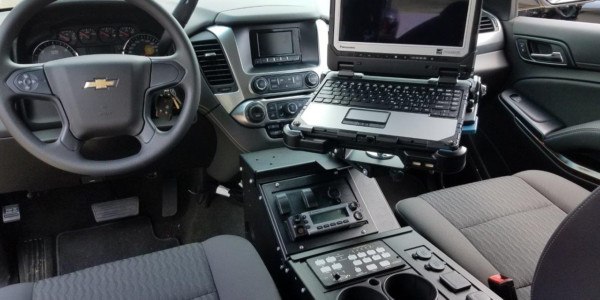
Key Considerations for Selecting a Mobile Workforce Automation Platform
Key considerations for selecting an mobile workforce automation platform
Mobile workforce management is a proven advantage that many fleets are adopting in and outside of their vehicles to leverage a competitive edge.
Using mobile technology to electronically automate tasks that were previously executed using clipboards and job sheets, workforces are removing reliance on paper, accessing information in real-time and aggregating major productivity gains.
With a plethora of devices to choose from, each marketed as being tougher and better performing than the last, it can be difficult to select the one that best fits the use case or the in-vehicle deployment. Manufacturers like Dell, Getac and Panasonic currently dominate the rugged space, while both Android and Apple commercial tablets and phones are being deployed (with limited success) to automate, streamline and improve some aspects of the working day.
With everything from food deliveries through to emergency services standing to benefit from automation, here we will take a look at the features and benefits of the hardware options available to manage workforces, while taking factors including dismounting, use in vehicles and operating environment into account.
The mobile phone and mobile workforce management dilemma…

Mobile phones have transformed the way we live our personal lives. The same is true in the mobile workforce management domain. With initial gains to be made from their size and cost, field workers can use mobile phones to run simple workflow tasks that benefit from portability, like recording proof of delivery.
Deploying mobile phones to run applications with more complex interfaces such as data capture and route optimisation presents an issue, however. Their smaller display size makes them unsuited to tasks with more complex interfaces or information onscreen. At the same time, their construction means they will not cope in outdoor environments where they may be dropped and be exposed to rain or bright sunlight – meaning more downtime and ultimately, lost revenue. In this instance, rugged handhelds are a viable alternative. While addressing the breakage concern, rugged handhelds are limited in terms of screen and O/S compatibility, and therefore not built to perform applications requiring a high level of computing power or onscreen visibility.
Mobile phones present some tempting advantages. However, the reality for field workers is that they are not compatible with use in fixed installations, tough conditions or storage overnight in vehicles. Workforces thinking of using mobile phones to meet their mobile workforce management needs will ultimately have to weigh up which is more important: portability and cost, or usability and protection as a means to reduce cost of ownership and downtime from breakages.
Commercial tablets vs rugged tablets

When a mobile phone won’t cut the mustard due to display size and both vehicle and use case requirements, the commercial tablet market delivers some attractive benefits. Like phones, commercial tablets are cost-effective and quick to deploy. They also have the added benefit of being able to run more complex applications. Unfortunately, and again like phones, they are also fragile and unsuited to vehicle installations, use in bright conditions and frequent undocking. Devices like iPads will deliver everything you need to run simple mobile workforce management applications smoothly, but for use cases that demand operation in tougher, dirtier conditions – where rough handling is likely – something more robust has to be implemented.
Rugged tablets are the ideal solution for mobile workforces looking to manage tasks in more challenging environments, such as inside a vehicle or outside in all weather conditions. But when choosing a device, workforces should remember that not all rugged tablets are created equal.
Recently released models from the likes of Samsung and Captec are good examples of rugged tablets with low initial costs, representing value for money in an otherwise expensive marketplace. With IP-rated water protection for dependable use in the rain, drop-testing up to 1.2 metres and device-specific docking stations, these models are ideal for applications needing outdoor use with both a mounted and dismounted requirement. The only potential disadvantage is that they are not compatible with external antennas, slightly limiting their performance in industries and applications demanding real-time information access in more built-up locations through mobile data and GPS positioning.
Then, there are fully-featured rugged tablets which deliver several further mobile workforce management advantages. They are able to link to external antennas for enhanced connectivity, and with rigorous testing and certification to stringent military standards, allow workforces to use technology with confidence in any vehicle and in any environment. Specified with wide operating temperature ranges, rugged tablets are suitable for fixed installations and the most extreme applications like waste management, construction and even military use cases.
Through hot swap batteries and sunlight readable displays, these models are ideal for applications needing to power through longer than a working day and in all conditions, both in and out of vehicles. Rugged tablets are also compatible with a range of additional peripheral equipment such as barcode readers, providing the flexibility and performance to meet a wider range of application requirements. While the initial costs are typically considered outside the budget of many fleets, rugged tablets lower total cost of ownership in especially challenging applications and often prove to be a savvy investment.
The role of rugged laptops in mobile workforce management…

Despite their extensive list of uses, handheld devices won’t always fit the bill for mobile workforce management requirements. For applications needing computers to perform the role of a mobile office, rugged laptops come with distinct benefits to be strongly considered. With both semi and fully-rugged models available, there are options to satisfy the cost and protection needs of most workforces.
While these devices are bulkier and therefore harder to dismount and transport into the field than their handheld counterparts, rugged laptops are more versatile and have greater computing power. They also have additional connectivity and features, chief among them are built-in keyboards, which enable the laptops to be more versatile and function like a mobile office, as well as provide effective workforce management.
Mounted and dismounted use cases…

The considerations for mobile workforces don’t relent after narrowing down the options and selecting a device. Whether to mount hardware in vehicles or leave it loose presents another dilemma. For applications with very frequent dismounting requirements – or no need to charge devices between jobs – mounting might be unnecessary, however it will still deliver significant safety, security and accessibility advantages. For all other applications, workforces will want to strongly consider the benefits of mounting.
Through a professionally installed vehicle dock, applications including route management and navigation can be displayed real-time in vehicles. Mounting devices in docking stations can also provide a reliable means of charging in transit, ensuring hardware is always kept on and ready. With lockable storage, mounting is also a highly effective way of deterring thieves while maximising safety, even in the event of a vehicle collision.
Horses for courses…

Mobile technologies allow workforces to make simple improvements and achieve wider productivity gains. But with such a wide range of devices across multiple form factors and manufactured from a long list of suppliers, workforces are spoilt for choice and presented with something of a selection headache.
The initial trade-off between portability and screen size will get things moving, with further considerations then having to be taken on aspects including ruggedisation, operating environment, use case and battery life. In what is very much a horses for courses scenario, workforces will do well to ensure they take the right considerations and back the right runner for the trip.
The table below summarises the strengths and weaknesses of each hardware option available to run mobile workforce management applications.
Mobile Phones |
Strengths:
Lowest cost Highly mobile Battery typically lasts a day without charge |
Weaknesses:
Not protected for regular outside use Little to no drop protection Small screen size not suitable for displaying more complex applications/interfaces Little to no vibration protection for in vehicle use |
Commercial Tablets |
Strengths:
Low cost Range of screen sizes supporting more complex applications/interfaces |
Weaknesses:
Not protected for regular outside use Little/no drop protection Little/no vibration protection for in vehicle use |
Rugged Handhelds |
Strengths:
Highly mobile, suitable for regular outdoor use Optional integrated peripherals such as barcode readers |
Weaknesses:
Less OS support, limiting application choice Low screen size not suitable for displaying more complex applications/interfaces |
Rugged Tablets |
Strengths:
More cost-effective than rugged tablets Optional integrated peripherals such as barcode readers Range of screen sizes supporting more complex applications/interfaces |
Weaknesses:
No external antenna support to improve GPS/3G/4G connectivity |
Fully Featured Rugged Tablets |
Strengths:
Tested to work in very challenging environments Hot swappable batteries increase tablet uptime without charging Support external antennas to improve GPS/3G/4G connectivity Optional integrated peripherals such as barcode readers Range of screen sizes supporting more complex applications/interfaces |
Weaknesses:
Initial purchase costs are more expensive, though total cost of ownership may be lower |
Semi-rugged Laptops / Convertibles |
Strengths:
Versatile with built in keyboard, enable office-like use as well as fixed mobile workforce management applications More cost-effective than rugged laptops |
Weaknesses:
Bulky, less suitable for dismounted mobile use Not usually protected for outdoor use in wet conditions |
Rugged Laptops / Convertibles |
Strengths:
Versatile with built in keyboard, enable office-like use as well as fixed MWM applications Suitable for use in all weather conditions |
Weaknesses:
Bulky, less suitable for dismounted mobile use Less cost effective than semi-rugged laptops |

